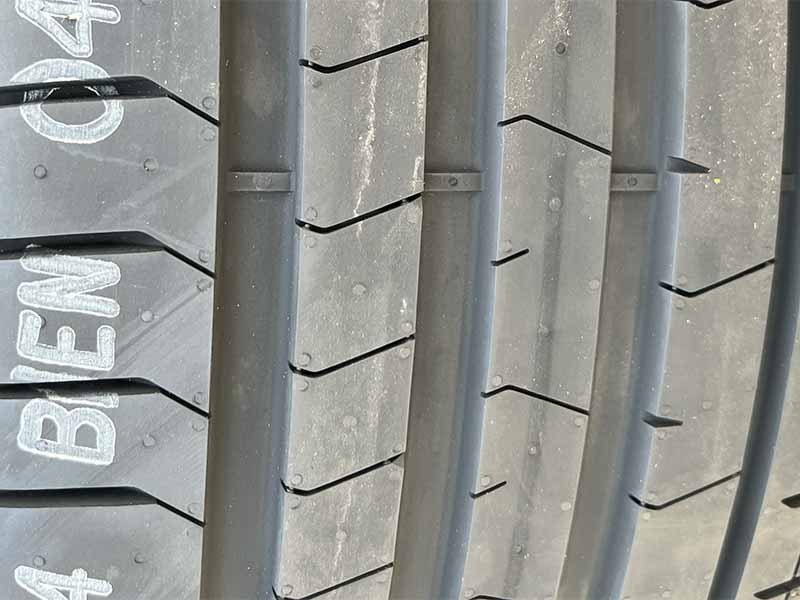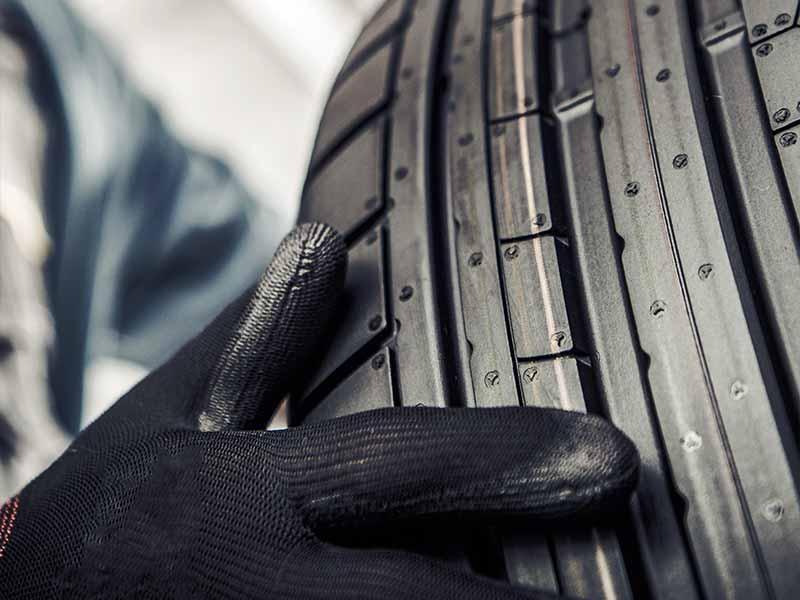Checking tire tread is an important part of tire maintenance. It should be done regularly along with checking tire pressure, tire rotation, wheel balancing, and alignment.
A tread depth gauge is the best tool for checking tire tread depth, but it can also be done with a coin.
You Should Check Your Tire Tread Every Month – NHTSA
The NHTSA states that you should check tire tread depth monthly. A visual inspection should be adequate with more thorough inspections performed every six months.
Visual inspections should include looking across the entire width of the tire tread and around as much of the tire as possible. Uneven wear may go unnoticed if you’re not checking tire tread thoroughly.
Semi-annual inspections should be performed with a tire tread depth gauge or with the penny tire test.
If your tire’s tread depth appears low during a visual inspection, you should measure the tread depth to determine if it is time to replace your tires.
Tire tread depth is an important safety factor and your tires are one of the most critical components of your vehicle. They are the only points of contact between your car or truck and the road surface.
Regularly checking your tire’s tread depth should be a habit we all make.
Let’s take a closer look.
Tire Wear Indicator Chart
How To Check Tire Tread
Your tire’s tread depth can be checked with a tread depth gauge, a coin, or by checking the wear bars. Let’s go over how each method to check tire tread depth so you can decide which method you will prefer to use.
How To Check Tire Tread With A Gauge
The main benefit of a tread depth gauge is that it will provide you with an accurate measurement of your tread wear.
To use a tread depth gauge, insert the probe into one of the main grooves between tread ribs and press down until the shoulders of the gauge rest on top of the tread blocks around the groove. You can then remove the gauge to read the measurement.
There are a few different types of gauges, but most of them use a probe inserted into the tread pattern to measure the depth of the tire tread.
You can learn more about how to use a tread depth gauge in our detailed article.
How To Check Tire Tread With A Coin
The quarter test and penny test are the most common methods to check tire tread depth with a coin.
Quarter Test
The quarter test requires a Washington Quarter, which is a little less common these days, inserted upside down into a tread groove.
- If the top of your tire tread touches Washington’s head you have enough depth.
- If the top of your tire tread doesn’t touch Washington’s head you should consider replacing your tires.
Penny Test
The penny test works similar to the quarter test but provides a little more accurate feedback. Insert a penny with Lincoln’s head upside down into a tread groove.
- If the top of your tread reaches up to or beyond Lincoln’s forehead, you have plenty of tread depth left.
- If the top of your tread is between the top of Lincoln’s head and his forehead, you should consider replacing your tires soon.
- If the top of your tread reaches only to the top of Lincoln’s head or less, you should replace your tires immediately.
How To Read Tire Wear Bars
Tire wear indicator bars are slightly raised rubber bars molded into the main tread grooves of your tires. Most tires will have this feature, although some may have different designs.
The wear bars are exactly 2/32″ tall which means that once your tire’s tread wears down to being flush with the wear indicator bar you know it’s time to replace your tires.
If you regularly inspect your tire’s tread depth you can check for when the tire wear is getting close to the wear bars and be prepared to replace your tires before they reach this point.

How Do You Know When Your Tires Need Replacing?
Tires must be replaced when the tread depth has reached 2/32″ or have reached an age of 6 years. While you should replace tires at this point, you may want to consider replacing them sooner.
As tires wear down and lose tread depth, they lose performance. By the time a tire reaches 4/32″ of tread depth, they will perform significantly worse than new tires.
Stopping Distances In Wet Weather Conditions
With every little bit of tire wear that occurs, you lose some performance from your tires on wet roads. Tread grooves are designed to channel water away from the contact patch. The deeper the grooves, the more efficiently they are able to work and maintain traction in rainy weather.
The following stopping distance chart illustrates the loss of traction as an increase in stopping distance in moderate rain.
Safe Tread Depth
Safe tread depth is generally considered to be 5/32″ and up. New tires typically have 11/32″ or 10/32″ of tread depth. Once worn down to 5/32″ they have lost at least half of their tread depth but will have lost much more wet weather performance. They will still perform quite well at this point but stopping distances will be increased.

Good Tread Depth
Tread depths between 4/32″ and 3/32″ are considered good if used with care in rainy weather but it is recommended that you replace tires at this point. It is not required but considering the much longer stopping distances on wet surfaces, it is a wise precaution.

Worn Out Tires
Tires with only 2/32″ of tread life are considered worn tires and need to be replaced immediately. This is the legal limit and can be quite dangerous when used in the rain.
Stopping distances can be approximately twice that of new tires and the chance of hydroplaning is greatly increased.

How Long Do Tires Last?
Different tire designs will last differing amounts of time. Most tires will last 50,000 to 60,000 miles. Performance-oriented tires will typically only last 30,000 to 35,000 miles.
You can refer to your tire warranty to see how many miles the tire manufacturer will guarantee to get a good idea of how long a set of tires will last for you.
The UTQG treadwear rating will also help give you a good idea of tread life.
Additional Tire Maintenance Tips
There’s more to tire maintenance than just monitoring tread depth, however. Let’s briefly cover some of the other recommended tire maintenance practices you should follow and how often they should be performed.
Check Tire Pressure
Maintaining proper tire pressure is important to even tire wear and long tire life. Your tire pressure monitoring system is designed to alert you when your tire pressure is below 25% of the recommended air pressure.
Relying on your TPMS system is not wise. You should check your tire air pressure monthly when you’re performing your monthly tire tread inspections to maintain the proper tire pressure shown on the tire information sticker in the driver’s door jam.
Regularly Rotate Your Tires
Having your tires rotated regularly will help maximize tire life and promote even tread wear. Also, tire rotation is usually a requirement for maintaining your tire’s mileage warranty. The mileage allowed between rotations varies depending on the manufacturer and tire model.
Rotating your tires every 5,000 miles should meet or exceed most tire warranty requirements.
Balance Your Tires
Tires can become unbalanced for many reasons. Curb strikes, potholes, loose wheel weights, uneven tread wear, bent wheels, and more can all lead to out-of-balance tires.
When your tires are out of balance they will not wear evenly and can make noise. Rebalancing your tires every 10,000 miles will help ensure they are spinning smoothly, wearing evenly, and gripping the road surface properly.
Perform A Wheel Alignment
When your wheels fall out of alignment your tires will wear unevenly and shorten their lifespan. Alignment problems are usually caused by suspension damage from curb strikes and potholes but can also be caused by normal wear and tear over time.
It’s worthwhile to have a wheel alignment performed every 10,000 miles to help ensure your car or truck is tracking true and the tires are not suffering from unusual wear patterns.
Resources
Below are some links you may find helpful when learning about tires
- Tire safety ratings and awareness | Tire wise – NHTSA
- How to measure tire tread depth – Goodyear Tire
Final Thoughts
Your tire’s tread groove is designed to channel water out and away from underneath your tires. As they wear down the tread remaining has a much shallower groove to perform this important job.
While the legal limit for tread depth is 2/32″ in most states, when the remaining tread depth is 4/32″ or less, it is recommended that you replace tires instead of waiting.
Tire safety is an important factor that is often dismissed by average drivers. Hopefully, you have been able to understand better how tread depth affects stopping distances and can now make a better-informed decision about when to replace your tires.
Good luck and happy motoring.






